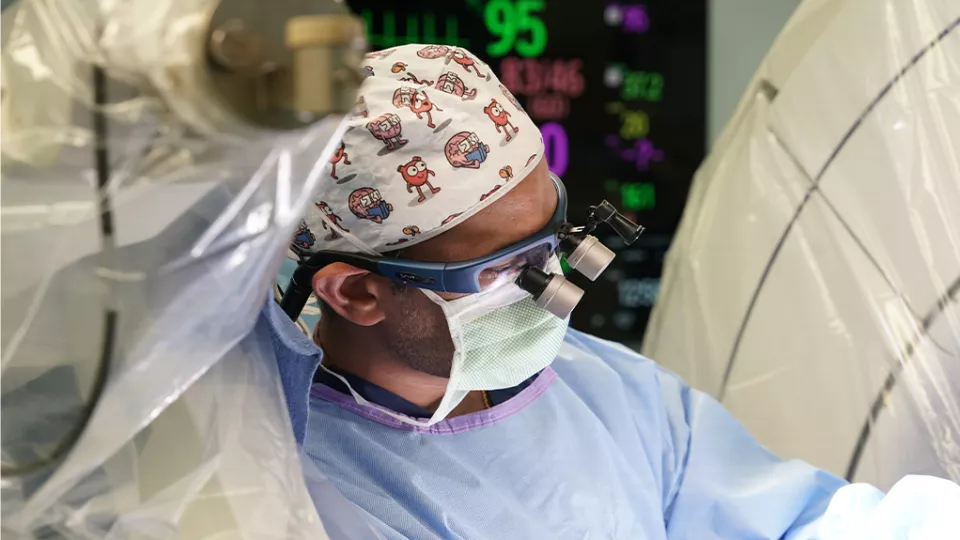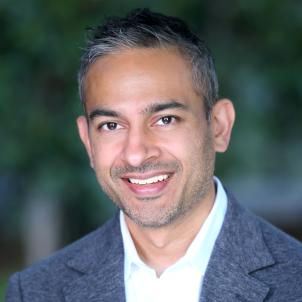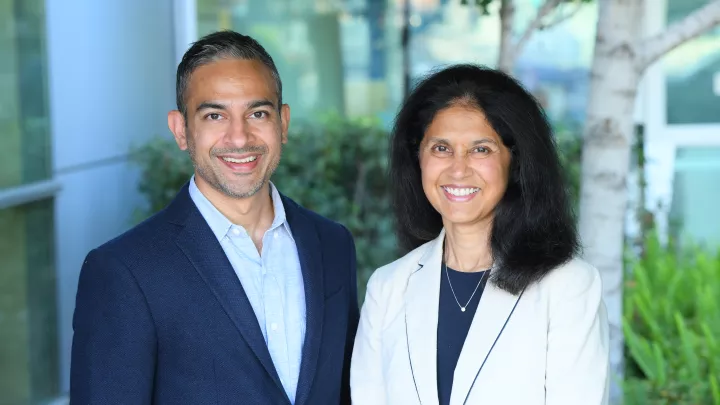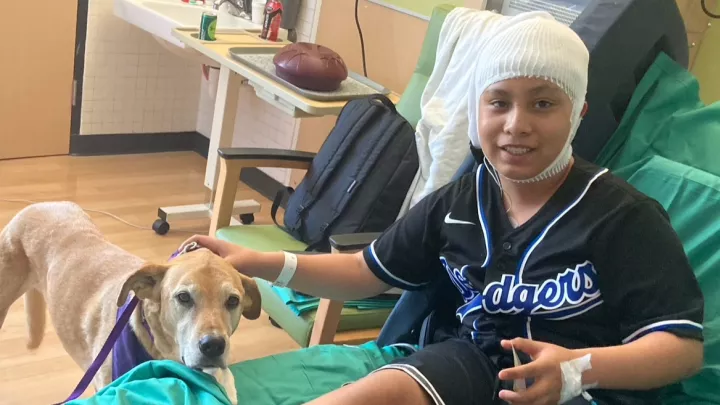
Virendra R. Desai, MD, at the surgical robot during CHLA’s first thalamic responsive neurostimulation procedure
CHLA Performs Its First Thalamic RNS Procedure for Epilepsy
The Children’s Hospital Los Angeles Comprehensive Epilepsy Center team recently performed its first thalamic responsive neurostimulation (RNS) procedure. This groundbreaking technology is placed deep in the thalamus, a control center for the brain. There, it continually monitors a patient’s brain waves—and can stop seizures before they even start.
Virendra R. Desai, MD, led this five-hour procedure, which was performed in a child with generalized epilepsy whose seizures had not responded to medications or a vagal nerve stimulator (VNS). The patient is doing well.
Dr. Desai is Surgical Director of the Comprehensive Epilepsy Center at Children’s Hospital Los Angeles—a Level 4 center that offers the most advanced, highest-quality care for children with epilepsy. He shares how thalamic RNS works, what the data shows so far, and why it’s a game-changer for kids with generalized epilepsy.
Why are you excited about thalamic RNS?

First, it works really well. People across the world have reported an average seizure reduction of about 80%. There is a range of responses, but many patients see a greater than 90% reduction in seizures.
But the most exciting thing is that this technology is being applied to patients who previously had no other options. If children were still seizing after failing medications and a vagal nerve stimulator, or trying a ketogenic diet, we had nothing else to offer them.
And there are a lot of patients who fit that category. They fail everything, but thalamic RNS works for them. We are now evaluating three more patients for this treatment.
What happens during the surgery? How did you prepare?
Prior to surgery, we do a special MRI scan that shows us the different parts of the child’s thalamus. We need to put the electrode in a very specific part of the thalamus, and that area is only about 5 millimeters in diameter. It’s a really small target, and it’s way in the center of the brain.
The patient also gets a CTA scan, where we inject contrast so we can see the blood vessels. And then these images are combined, and that allows me to plan out a starting and ending point for the electrode. We need it to go in that very specific part of the thalamus, and it needs to be far from any blood vessels.
In the operating room, we put all that information in the surgical robot. And then we do the whole surgery through the robot, which allows us to achieve our target placement within a millimeter. The tail end of the electrode is then connected to a battery that sits underneath the skin in the bone.
Virendra R. Desai, MDThe risk of bleeding is less than 1%. The risk of infection is also less than 1%. If you compare it to operations like the vagal nerve stimulator, the risk of complication is similar.
How long does it take to see seizure reduction?
It takes three to six months to see the full effect. Initially, the device only records seizures. After one month, we turn the stimulation on, but we usually start with the lowest settings and then make adjustments each month.
It’s a smart device, so epileptologists can continually adjust it to respond to certain brain waves or to send a longer, stronger, or more frequent impulse. You can really fine-tune it to the individual patient.
How safe is thalamic RNS surgery?

It’s very safe. The surgical technique has been around for nearly 80 years.
Because of the highly detailed preplanning, the risk of bleeding is less than 1%. The risk of infection is also less than 1%. If you compare it to operations like the vagal nerve stimulator, the risk of complication is similar.
It’s also completely reversible. We can take the device out if the patient decides they don’t want it anymore.
When considering if thalamic RNS is appropriate, clinicians and patient families should compare the risk of surgery to the risk of continued seizures.
While brain surgery sounds scary, the risks from continued seizures—especially in a child—are far, far greater. Continued seizures can lead to delayed development, poor cognition, depression, anxiety, weakness, and even mortality—all at significantly higher rates than the risk of surgery.
Do you see thalamic RNS as replacing vagal nerve stimulators?
Eventually, yes. A vagal nerve stimulator is our least effective surgical option. But because the VNS involves surgery in the neck, and not the head, most clinicians today still say, “Let’s try VNS first.”
Thalamic RNS just hasn’t been around long enough yet for physicians to feel comfortable with bypassing VNS altogether. But that’s definitely going to change. As we get more data and see how well patients respond, I think this will be standard practice.
What makes CHLA an ideal place for thalamic RNS?
This is a newer procedure that is only available at advanced Level 4 epilepsy centers like CHLA. In addition, epilepsy care is not about just one surgery or treatment.
At CHLA, we offer a comprehensive program dedicated specifically to children and adolescents. We work as a team, with the latest technologies—including minimally invasive and robotic techniques—to pinpoint the specific type of epilepsy a child has and decide on the best treatment plan. It’s a multidisciplinary approach, and that allows us to deliver the best care and outcomes for each child.


